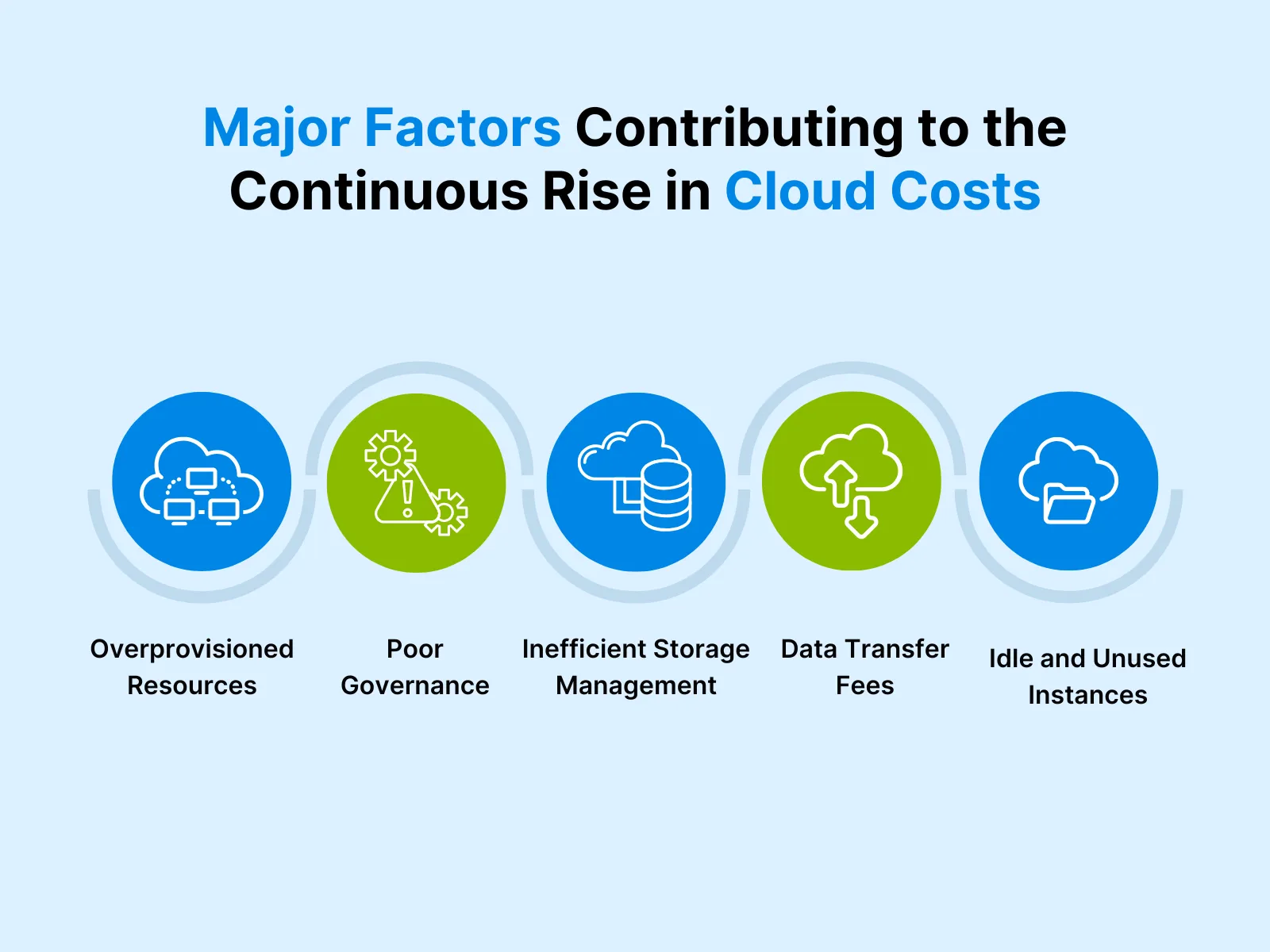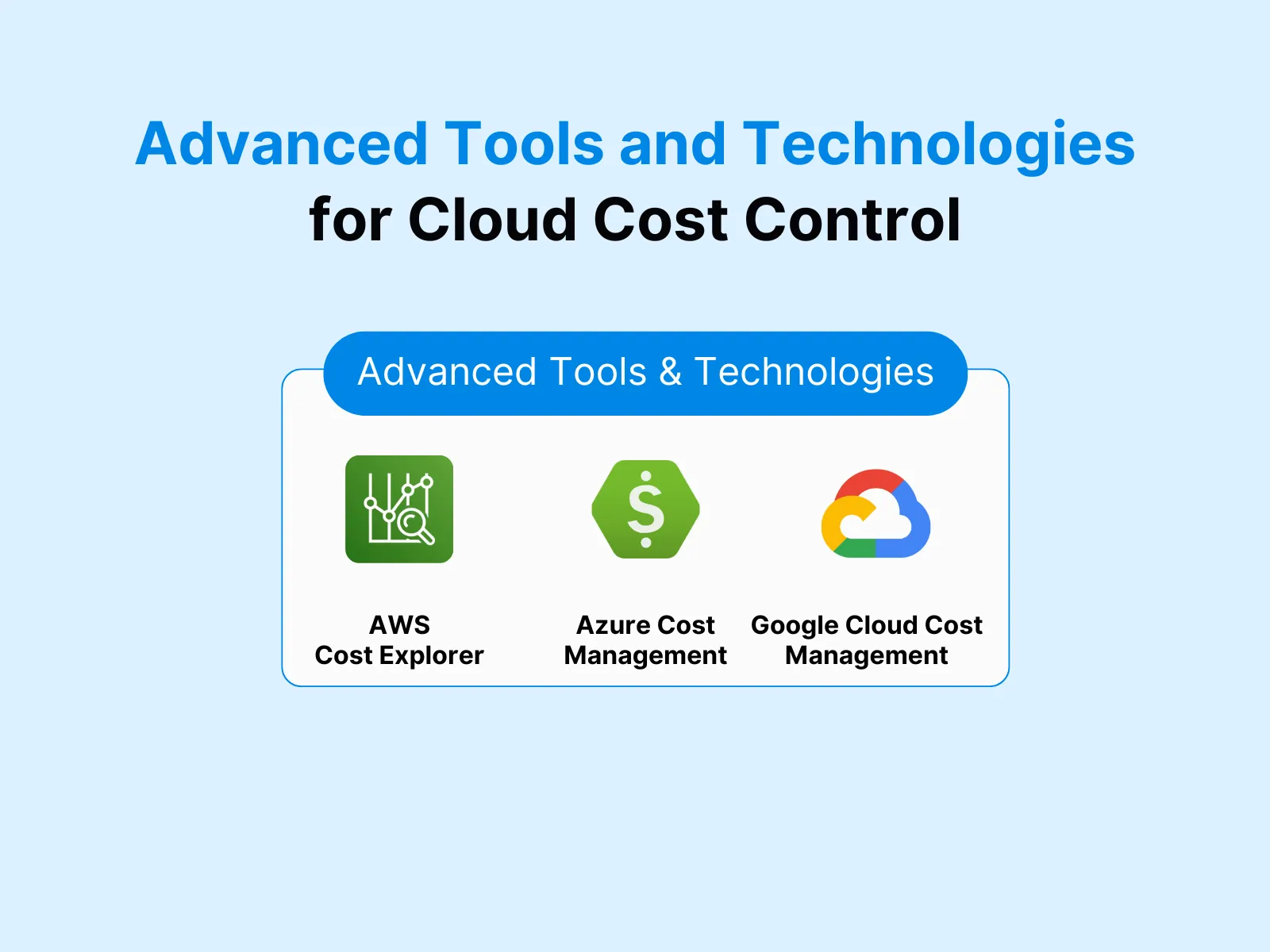Cloud Cost Optimization Made Simple: Minimizing Expenses, Maximizing ROI
In this digital era, cloud adoption is rapidly gaining traction, but so are the associated costs. This blog explores optimal and viable cloud cost optimization strategies to help enterprises reduce overheads, maximize ROI, and ensure financial efficiency while driving sustainable business growth.

As cloud integration continues to soar, managing expenses becomes critical for enterprises to minimize overhead costs and drive scalable growth. We came across a Gartner survey that says that enterprises will overspend 30% on cloud services due to inefficient resource allocation and lack of proper cloud cost optimization strategies.
In addition to Gartner, the HashiCorp 2024 State of Cloud Strategy Survey has also raised similar concerns stating that 66% of the organizations have increased their expenditure on cloud infrastructure, while 91% of enterprises are wasting their money on the cloud.
The rising cloud infrastructure costs lead to several challenges and pressing issues. For instance, many enterprises struggle with ballooning cloud costs as their usage scales, with limited visibility into inefficiencies in resource allocation. Unpredictable expenses due to dynamic pricing often lead to budget overruns. Some enterprises underutilize resources, such as idle or over-provisioned instances, leading to unnecessary spending.
So, what’s the viable solution? The answer is cloud cost optimization. This is a viable and strategic approach that allows organizations to control expenses while ensuring scalability. It helps them to right-size resources, mitigate waste, and leverage cost-effective models. Additionally, cloud cost reduction enables businesses to create sustainable and agile cloud infrastructure, and drive long-term growth, and operational excellence.
Cloud Cost Reduction: What It Means and Why It Matters for Enterprises

Optimizing enterprise cloud cost is the strategic process of managing and reducing cloud expenses while maintaining performance and scalability. It involves fine-tuning cloud resource usage, right-sizing workloads, and leveraging cost-saving pricing models to ensure that enterprises only pay for what they need - maximizing value while minimizing unnecessary expenses.
By implementing automation, monitoring, and governance, enterprises can ensure efficient cloud usage without compromising operational needs.
Main Contributors to Rising Cloud Costs
The key factors that contribute to increasing cloud expenses and impacting the overall budget estimation include:
Overprovisioned Resources – Allocating more computing power than necessary results in wasted spending. Enterprises often fall into this trap when resources are overestimated, leading to unnecessary costs.
Poor Governance - Without proper monitoring and the implementation of effective policies, enterprises can face uncontrolled cloud usage and unexpected costs. Establishing clear governance frameworks helps prevent such inefficiencies.
Inefficient Storage Management - Storing redundant or rarely accessed data can significantly hike costs, especially when not using appropriate storage tiers. Enterprises can reduce costs by archiving infrequent data to lower-cost storage options.
Data Transfer Fees - Moving data between cloud regions or migrating from one cloud provider to another (e.g., from Azure to AWS) incurs additional fees. Minimizing unnecessary data transfers helps control these costs.
Idle and Unused Instances – Running cloud instances that are no longer needed contributes to unnecessary overhead. Regular audits to decommission unused instances can help reduce these avoidable costs.
Advantages of Cloud Cost Optimization
Enterprises of all sizes and types must prioritize optimizing cloud spending strategically to balance cost and performance. Unchecked cloud expenses can strain budgets, reducing profitability and limiting growth opportunities.
Businesses must control costs through optimal resource allocation to ensure they keep upscaling without financial drains. A well-optimized cloud infrastructure amplifies performance and improves application speed, reliability, and user experience.
Additionally, organizations can look to maximize ROI from cloud investments and reinvest savings into redefining innovation, nurturing talent, and new business opportunities. Strategic cost optimization also strengthens financial predictability, helping organizations adapt to market changes while maintaining operational excellence and long-term sustainability.
Maximize ROI, Minimize Cloud Costs, and Scale Your Business Efficiently
Adopt Proven Cloud Cost Management Practices for Greater Operational Excellence
Effective Strategies for Cloud Cost Optimization
Effective cloud spending optimization requires a strategic approach encompassing right-sizing, reserved instances, multi-cloud strategies, and storage optimization. At the same time, organizations must implement cloud ERP for scalable growth and best optimization practices to decrease overheads, and ensure long-term financial efficiency in cloud operations. The key strategies include:
Right-Sizing Cloud Resources
Right-sizing is adjusting the cloud resources to align with actual usage, preventing overprovisioning, and reducing unnecessary costs. Enterprises often allocate more computing power than required, leading to wasted spending.
Here, businesses analyze workloads and scale resources based on demand to ensure optimal efficiency without excess capacity. They can use advanced auto-scaling tools and performance monitoring systems to identify underutilized instances and downsize or reallocate resources efficiently.
Regular audits and automated recommendations from cloud providers further enhance resource allocation. Right-sizing ensures that companies pay only for what they use, improving cost efficiency and maximizing cloud investments.
Implementing Reserved Instances
It is crucial to note that reserved instances provide significant cost savings for predictable workloads as compared to on-demand pricing models. Hence, if businesses integrate and use reserved instances for long terms, they can save up to 60% on overall cloud expenses.
Reserved instances are ideal for applications with stable resource requirements, such as databases, analytics workloads, and enterprise applications. Cloud providers offer flexible options, including convertible reservations that allow modifications based on evolving needs.
Implementing reserved instances not only lowers costs but also provides better budgeting predictability. Businesses can allocate savings to innovation and expansion while maintaining reliable cloud performance.
Leveraging Multi-Cloud and Hybrid Architectures
A multi-cloud or hybrid strategy enables enterprises to optimize workloads across different platforms based on pricing, performance, and availability. Rather than relying on a single provider, businesses can distribute workloads to take advantage of cost-efficient services.
Implementing a multi-cloud strategy allows them to prevent vendor lock-in and negotiate better pricing and service terms. Meanwhile, hybrid cloud architectures and solutions combine on-premise infrastructure with public cloud services, enabling businesses to manage sensitive data cost-effectively.
Additionally, choosing a multi-cloud approach allows organizations to allocate workloads based on real-time cost analysis, ensuring maximum efficiency. This enables them to boost resilience, minimize risks, and optimize cloud spending.
Optimizing the Cloud Storage
Are you overspending on excessive cloud storage? Well, this may be an intricate issue if the data is not managed efficiently. The best way to reduce expenses is to archive infrequently accessed data in lower-cost storage tiers while ensuring critical data remains readily available.
Businesses can hire AWS developers to implement cloud lifecycle management, monitor data movement, and transfer older files to cost-effective storage solutions such as cold storage or archival options. The experts also help to delete redundant or obsolete data, eliminating unnecessary costs.
Top cloud service providers like AWS, Azure, and GCP provide compression and intelligent tiering features to streamline storage expenses without compromising accessibility. Enterprises can look to integrate smart storage management solutions to lower costs and improve operational efficiency.
Advanced Tools and Technologies for Cloud Cost Control

Before discussing and analyzing the critical cloud cost-saving tools and technologies, we must understand what cloud cost management is. It is a strategy that monitors, analyzes, and optimizes cloud resource expenses, helping organizations to control spending and maximize cloud service investment value.
As organizations are looking to invest and leverage cloud expense optimization tools, they have a few top options to explore. These include:
AWS Cost Explorer
AWS Cost Explorer is a cost management tool that visualizes and analyzes AWS spending. It offers interactive reports, cost forecasts, and detailed insights into usage patterns. With customizable filters, businesses optimize budgets, detect anomalies, and enhance cost efficiency, ensuring better financial planning and resource allocation within AWS environments.
Azure Cost Management
Microsoft Azure Cost Management is a suite of FinOps tools that allow organizations to analyze, monitor, and optimize their cloud spending by offering an in-depth analysis, budgeting, and forecasting. The core features of this tool include cost allocation, anomaly detection, and multi-cloud support. Businesses can gain improved financial visibility, create governance policies for better accountability, and manage resources efficiently.
Google Cloud Cost Management
Google Cloud Cost Management is an advanced cloud cost-reduction tool that monitors, controls and optimizes cloud spending. It helps enterprises gain real-time visibility of current trends and forecasts, establish clear accountability across the organization, and optimize cloud cost usage using intelligent recommendations. Additionally, businesses can also control expenses with robust governance policies and permissions.
Automation tools enable businesses to adjust their resource allocation automatically based on usage patterns. They also upscale or downscale cloud services based on the demand to save unused resources. According to a popular blog, AI and automation can substantially reduce cloud costs by 20% to 30% during the first few months of implementation. Predictive analytics, on the other hand, helps anticipate future spending and potential overturns.
Cost forecasting tools analyze historical cloud usage and spending patterns to predict future expenses. They help enterprises budget effectively, optimize resource allocation, and prevent unexpected cost spikes, ensuring financial control and strategic cloud investment planning.
Streamline Cloud Cost Optimization with Industry-Leading Tools
Track, Forecast, and Scale Cloud Resources for Maximum Efficiency
Real-World Examples of Cloud Cost Reduction
We are now going to explore a real-world few case studies of companies serving different industries that have successfully optimized their cloud costs.
Case Study 1
Let’s start the discussion with a leading eCommerce company Etsy that migrated its data center and eCommerce platform to Google Cloud Cost Management to grow its business and meet customer expectations with reduced costs and infrastructure.
Moving to the Google Cloud Platform was a viable decision for the eCommerce platform as it successfully saved more than 50% in compute energy. Similarly, the company saw a reduction of 42% in compute costs using committed-use discounts, and other optimizations.
Case Study 2
The second successful story is that of Salesforce— a top-notch CRM SaaS provider that used VMware’s CloudHealth to optimize multi-cloud costs. CloudHealth by VMware enables Salesforce to gain improved visibility into cloud spending, governance, and automation, and enhance efficiency.
CloudHeath by VMware allows Salesforce to manage resources across different service providers, such as AWS, Azure, and GCP, ensuring cost control and operational agility. This approach enhances financial accountability, streamlines operations, and supports Salesforce’s growing SaaS model.
Case Study 3
Verisk is a global predictive analytics and decision-support solution provider that leveraged AWS Cloud Financial Management Services to better understand and govern costs. This implementation led to enhanced transparency in cloud resource usage and cost analytics.
They also integrated AWS Budgets for tracking expenses, Amazon Athena, and Amazon QuickSight for querying and visualizing cost data, and AWS Cost Explorer for analyzing spending trends. This allowed the company to optimize cloud usage and financial accountability.
Addressing the Key Challenges in Cloud Cost Management
Enterprises may have to tackle various intricate challenges while planning strategies for cloud integration and software solutions to transform fintech. At the same time, they also have to face different cost optimization issues which can be discussed below.
Challenge 1: Lack of Visibility
The lack of visibility into spending practices and usage is one of the prime reasons why enterprises struggle to manage costs. They may not have the right tools to determine cloud expenses and interpret cloud reports appropriately. The result is they end up spending much more than the budget estimate.
Choosing the right cloud management tools can help resolve the problem and provide them with detailed insights into cloud spending patterns. The tool also offers a holistic view of all cost centers and its usage reports to lower costs.
Challenge 2: Complex Multi-Cloud Environments
Optimizing costs in complex multi-cloud environments is challenging due to varying pricing models and resource allocations across providers. Without proper management, businesses may face inefficiencies and unnecessary expenses.
Effective cost optimization requires a unified strategy that includes real-time visibility into spending, automation for cost control, and governance policies to prevent resource wastage.
Leveraging cloud management tools helps streamline operations by providing insights into cost allocation and usage patterns. With a well-structured approach, businesses can enhance financial accountability and maximize cloud investments.
Challenge 3: Resistance to Change
Some organizations may be reluctant to adopt cost reduction optimization strategies due to various reasons, including concerns about disrupting workflows and performance impact. They may also have apprehension about unexpected downtime and resource constraints, leading to hesitation in implementing changes.
Proper planning and phased adoption can help address these concerns. Businesses can test optimization strategies in controlled environments to ensure smooth transitions without affecting critical operations.
Clear communication and stakeholder involvement are essential for overcoming resistance. Educating teams on the benefits of cost optimization fosters confidence, leading to better resource management and long-term savings.
Cloud Cost Optimization: What's Next?
Now that we have highlighted the key challenges and solutions related to optimizing cloud costs, it becomes essential to throw some light on emerging trends in cloud cost optimization.
As cloud adoption is gaining momentum, AI-powered optimization is revolutionizing cost management. These intelligent systems analyze real-time data, automatically adjusting resources to reduce waste and enhance efficiency. By predicting usage patterns, AI minimizes over-provisioning and ensures that workloads run at peak performance while maintaining cost control.
FinOps is yet another evolving trend that seamlessly integrates with finance and cloud engineering services to create a cost-conscious culture within organizations. It helps to promote financial accountability by aligning cloud spending with business goals, leading to more strategic decision-making.
Businesses are prioritizing energy-efficient cloud solutions, leveraging serverless computing and green data centers to reduce costs while minimizing their environmental impact.
The Importance of Continuous Cloud Cost Optimization
Cloud cost management isn’t a one-time task—it’s an ongoing process. As businesses scale, their cloud needs evolve, making continuous monitoring essential to prevent cost overruns. Without regular optimization, companies risk paying for unused resources or encountering performance bottlenecks.
Conclusion: Taking Control of Cloud Costs for Sustainable Growth
Cloud spending strategies are more than just reducing expenses—it’s about maximizing efficiency, enhancing scalability, and ensuring sustainable growth. By proactively managing cloud resources, businesses can reinvest savings into innovation, improve operational agility, and maintain a competitive edge.
With the right cost-control strategies, companies can prevent budget overruns, optimize performance, and align cloud spending with business objectives. This long-term approach fosters financial resilience and accelerates digital transformation.
Embracing cloud cost optimization today sets the foundation for future success, regardless of multi-cloud vs. hybrid cloud, enabling businesses to scale smartly while driving innovation and profitability in an ever-evolving digital landscape.
FAQs
Optimizing cloud costs helps businesses lower expenses, improve resource efficiency, and enhance performance. It prevents budget overruns, enables better financial planning, and supports scalability. Additionally, it allows organizations to reinvest savings into innovation and digital transformation, ensuring long-term growth and competitive advantage.
Key strategies include rightsizing instances, utilizing reserved and spot instances, automating resource scaling, eliminating unused resources, optimizing storage, and implementing FinOps practices. Organizations should also monitor usage, leverage cost-saving tools, and negotiate better pricing with cloud providers to maximize cost efficiency.
The latest trends that will shape and enhance cloud cost-saving strategies include AI-driven automation, predictive analytics, and advanced FinOps practices. Serverless computing, spot instances, and sustainable cloud strategies will gain more traction. Additionally, enhanced multi-cloud optimization and real-time cost monitoring will enable businesses to control expenses, while maximizing cloud efficiency.
Challenges include lack of cost visibility, unpredictable cloud usage, complex pricing models, inefficient resource allocation, and difficulty in tracking multiple services. Organizations may struggle with governance, automation, and balancing performance with cost-saving measures, making strategic cost management essential for cloud success.
TRooTech provides expert cloud cost optimization services by analyzing usage patterns, implementing automation, and leveraging AI-driven insights. It helps businesses identify waste, optimize resources, and implement cost-effective strategies, ensuring sustainable savings while maintaining high performance and scalability in cloud environments.

